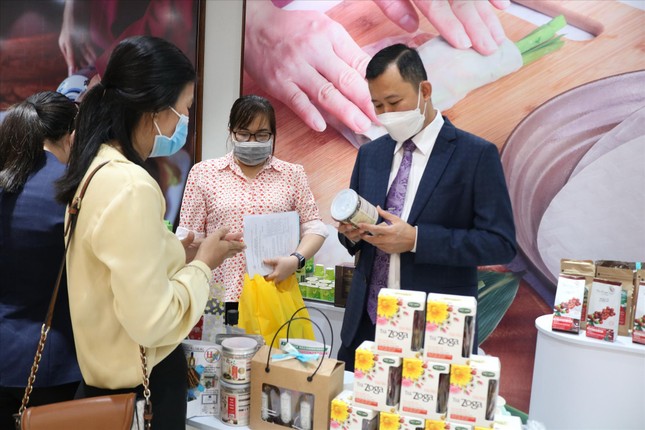 News
News
On March 17, Pacific Foods Joint Stock Company brought 16 tons of agricultural products and foodstuffs, including fish sauce, instant coffee, and premium beverages to the US market. Mr. Le Ba Linh, Chairman of Pacific Foods Joint Stock Company, said that the company had previously supplied orders to partners in the United States. However, this is the first time that the products of fish sauce, spices, agricultural products and beverages produced by Pacific Foods have had the opportunity to approach the US market in large quantities. It is expected that the shipment will arrive at the port of Long Beach, USA on April 10.
Mr. Linh also said that it is expected that in April 2022, Pacific Foods will continue to export a shipment of 28 tons of key agricultural products and spices to the US, including Phuc Loc rice and Youmi fragrant sauce. Currently, the company's Bless Mami fish sauce is the product that holds the top position in the fish sauce industry on the global e-commerce platform Amazon, with more than 18,000 products sold each month. Previously, in June 2021, Pacific Foods also exported the first two batches of Vietnamese lychee to the EU to enjoy incentives from the Free Trade Agreement between Vietnam and the European Union (EVFTA).
 |
|
Trade promotion programs bring Vietnamese goods to the world Photo: UP |
Also in March, for the first time, Tomcare Biotechnology Co., Ltd (Binh Chanh district) with the Chilica brand of fermented chili sauce brought 1,500 boxes of chili sauces worth $34,000 to Europe. “The product will be available in many stores and supermarkets in Europe, but still retain the Vietnamese brand. This is just a market survey shipment,” said Nguyen Thanh Hien, founder of Chilica.
With incentives from the Regional Comprehensive Economic Partnership (RCEP), Ho Chi Minh City enterprises have boosted exports to many major markets that were previously unable to compete because of tariff regulations, technical barriers. ... Mr. Tran Viet Anh, General Director of Nam Thai Son Import-Export Joint Stock Company, one of the leading enterprises in the plastic packaging industry in the domestic and export markets, said that at present, the company does not process it. which export products to many major markets in the world such as Korea, China, America; Europe. "Thanks to taking advantage of incentives from the RCEP Agreement, the company is expanding its export market," said Mr. Viet Anh.
Seafood is one of the typical industries that make good use of the Comprehensive and Progressive Agreement for Trans-Pacific Partnership (CPTPP) to promote exports. According to the Vietnam Association of Seafood Exporters and Producers (VASEP), 10 member markets of the CPTPP bloc account for over 25% of Vietnam's total seafood export turnover. In particular, Japan has always held the "top 3" position in Vietnam's seafood export markets for many years. However, the use of rules of origin to take advantage of tariff preferences for exports to this market has not been much.
Open potential market
Trade connection activities between domestic and foreign enterprises have also been taking place in Ho Chi Minh City over the past time. In particular, focusing on promoting new potential export markets from the effective new-generation free trade agreements that Vietnam has signed such as CPTPP, EVFTA...
At the meeting connecting businesses with the Middle East market, Mr. Nguyen Tuan, Deputy Director of the Investment and Trade Promotion Center of Ho Chi Minh City (ITPC), said that these countries have a huge import demand (ranging from 2 up to 8 billion USD); Vietnam's trade relations with the Middle East region mainly focus on the countries of the Gulf Cooperation Council (GCC). GCC countries have open economies, developed in terms of foreign trade; attracting foreign investment, tourism, services, diversifying the economy.
At the meeting connecting businesses with the Middle East market, Mr. Nguyen Tuan, Deputy Director of the Investment and Trade Promotion Center of Ho Chi Minh City (ITPC), said that these countries have a very large import demand (ranging from 2 to $8 billion).
According to Mr. Tuan, another advantage when exporting to the Middle East is that the import tax rate is only from 0-5% for goods imported from outside the bloc. Because of this, the Middle East becomes a potential market of Vietnam. As for Ho Chi Minh City, the Middle East is a market with plenty of room for exploitation. The main products that Ho Chi Minh City exports to the Middle East include seafood, vegetables, fruits, coffee, pepper, textiles, computers and electronic components, phone components....
Sharing the same view, Mr. Ngo Toan Thang, Ambassador Extraordinary and Plenipotentiary of Vietnam in Kuwait, said that opportunities for Vietnamese enterprises in the GCC market are wide open with many advantages. GCC block has large purchasing power, high solvency due to abundant financial resources. The structure of GCC's import and export products is quite consistent with Vietnam's strong export products. Import tax of GCC is quite low.
India is also a market being targeted by Vietnamese enterprises. Ms. Sumita Dawra, Director General in charge of the Department of Industry Promotion and Internal Trade (DPIIT), suggested that agriculture and food processing are areas where Vietnam and India both have strengths to cooperate and develop together. Currently, the Government of India offers special incentives to foreign investors investing in agriculture, horticulture, grain production, meat processing, dairy or agriculture-related services.